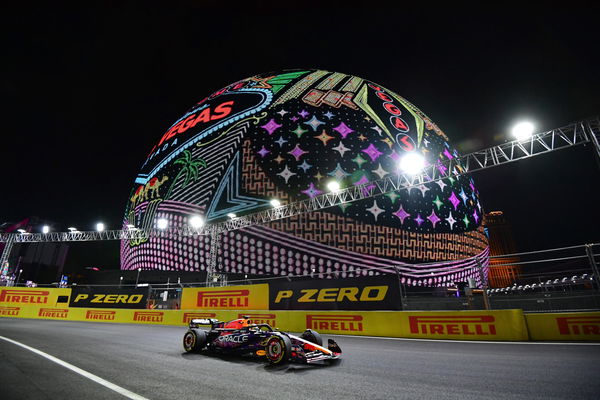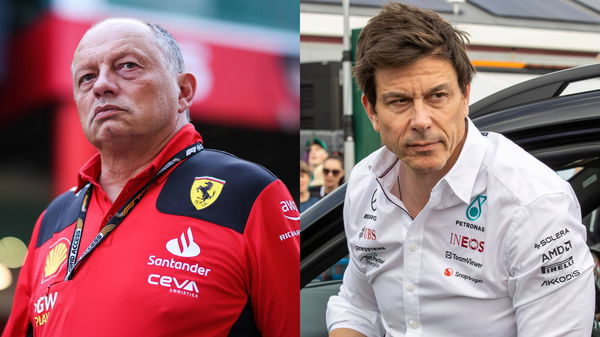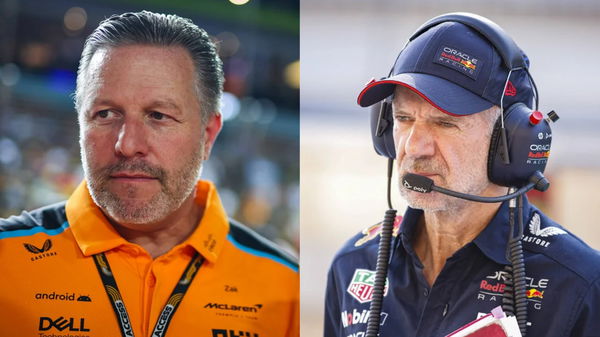What Is Out Lap in F1? How Does It Differ From In Lap?

Follow Us

USA Today via Reuters
Nov 16, 2023; Las Vegas, Nevada, USA; Red Bull Racing driver Max Verstappen of The Netherlands (1) during free practice at Las Vegas Strip Circuit. Mandatory Credit: Gary A. Vasquez-USA TODAY Sports
With the Formula 1 fever spreading like a pandemic, it’s important to get up to speed with all its rules, regulations, and lingo. As a fan dives deeper into the world of F1, attempting to broaden their horizons with the nitty-gritty of the sport, they quickly scratch the surface of the important rules with regular consumption of the sport. However, there are still some aspects that don’t get enough attention and get talked about as often. We’re going to discuss one such aspect, which is the F1 out-lap and in-lap. So you can store it in your F1 memory bank and use it as you please.
We are all aware of the all-important qualifying session during a weekend and its different types. During the session, which determines the starting position of each driver on race day, we often see and hear David Croft and Martin Brundle use terms like ‘out-lap,’ which also makes a frequent appearance on the timing board. So, let’s understand all these terms thrown around during a qualifying session and their importance.
What is an out-lap in F1, and what is its significance?
ADVERTISEMENT
Article continues below this ad
An out-lap is the first lap the drivers embark on right after leaving the garage and getting on the track. We see this scenario in every part of the qualifying session by each and every driver on the track. What is its significance? Let us tell you!

via Reuters
Formula One F1 – Abu Dhabi Grand Prix – Yas Marina Circuit, Abu Dhabi, United Arab Emirates – November 26, 2023 McLaren’s Oscar Piastri in action during the race REUTERS/Rula Rouhana
An out-lap is the first and crucial step the drivers take to get their car in the right window. The out-lap is slow and is used to warm the tires and brakes up enough to get the car ready for a fast lap or hot lap. This out-lap is crucial as, without the right temperature in the tires and the brakes, the cars tend to skid off the track and kiss the barriers or play with the gravel.
Trending

After US Congress Gets Involved, Ex-Ferrari Boss Reveals Why Letter to F1 Is Not the Solution to the Andretti Saga
May 12, 2024 02:49 PM EDT

Lando Norris Flashes $430,000 Bling as Rumored Supermodel GF Magui Corceiro Joins Him at Monaco Historic
May 11, 2024 05:26 PM EDT

Lando Norris’ Hops in Rare $2.5 Million Car at the Monaco Historique to Join an Exclusive List of People
May 12, 2024 05:00 PM EDT

Toto Wolff Needs a “Tough Guy” to Help Team, as Ex-Ferrari Boss Names Frederic Vasseur’s Top Target as the Man for Mercedes
May 12, 2024 04:27 PM EDT

Adrian Newey Returns to Championship Winning Car as Genius Designer Rivals Zak Brown at the Monaco Historique
May 10, 2024 05:51 PM EDT
Get instantly notified of the hottest F1 stories via Google! Click on Follow Us and Tap the Blue Star.

Follow Us
The out-lap not only ensures there is enough temperature in the tires and breaks but also lets drivers get a feel of the track before they embark on a flying lap (another name for a hot lap). This is precisely why we see the drivers weaving on the track with their cars like they’re bumper cars. It’s essentially to get the right temperature in the tires, and once they feel confident, toward the end of an out lap, the drivers speed up right after the last corner to start their hot lap, which gets their timing on the board.

About Cockpits in F1 Including Dimensions, Halo & Others
Safe to say, an out lap is the qualifying equivalent of a formation lap. Now let us talk about what comes after the out lap.
What is a hot lap during qualifying?
Hot, flying, or fast. These are the terms used to talk about a lap where the drivers register their qualifying times on the board. Every driver needs to register at least one hot lap time on the board in all of the sessions they take part in. However, more often than not, the drivers register two in each of the Q1, Q2, and Q3 sessions.

via Reuters
Formula One F1 – United States Grand Prix – Circuit of the Americas, Austin, Texas, U.S. – October 22, 2023 Alpine’s Pierre Gasly in action during the race REUTERS/Brian Snyder
The purpose, as we are all aware, is to set the grid for the race. The hot lap is the most important part of a qualifying session, and it’s when the drivers go the fastest as they push the limits of their F1 challenger. So, impeding a driver during their hot lap even warrants a grid penalty, which is a possible scenario considering that many cars are on the track during each qualifying session.
However, after a hot lap, the drivers instantly start thinking about the next steps, which brings us to the last terminology, an in-lap.
ADVERTISEMENT
Article continues below this ad
What is an in-lap and its purpose?
Taking the qualifying session as a sprinter’s routine on the track, an out-lap is the warmup, a hot lap is the sprint, and in those terms, an in-lap is the cool down. The in-lap serves the purpose of preserving the important fresh rubber on a tire as the drivers make their way back to the pits.
The in-lap comes right after a hot lap, and the purpose of driving slowly back to the pits, which the drivers do after the race as well, is to cool the car down and not put it under more stress. This lap cools down the tires and breaks to stop the graining process to get the best out of a “used set of tires” during the race.
ADVERTISEMENT
Article continues below this ad
Watch This Story: How Do Sprint Races Work at an F1 Grand Prix?
All these terms are ingrained in the world of F1 but aren’t important enough to be discussed separately. However, this was a quick guide for all the newcomers and some old who weren’t clear on the terms. Hope it helped!
Edited by:

Aditi Krishnan

